A high-aspect-ratio twin-hull vessel (acronymed HARTH) [1] refers to a certain design of catamaran vessels with small waterplane area. These vessels are built and used by the Islamic Revolutionary Guard Corps (IRGC) of Iran. Such design is considered relatively rare in military usage. [2]
The design of vessels is being described as looking "almost like a pond skater" because of the superstructure sitting above tall legs. [3] Due to the large length of the hulls in the water (also known as pontoons) and also the high height of the deck above the surface, it has a high length-to-width ratio (and is thus called high-aspect-ratio). [4] This design enables small speedboats to move under the ship, which can technically make certain tactical scenarios possible. [3] In comparison to a conventional catamaran, HARTH design allows decreasing the drag forces of the hull and thus breaking the seawater during sailing more easily, as well as more transverse stability in harsh sea states as a result of low heave, pitch and roll motion. [4]
The structure is made of aluminum. [1]

A small waterplane area twin hull, better known by the acronym SWATH, is a catamaran design that minimizes hull cross section area at the sea's surface. Minimizing the ship's volume near the surface area of the sea, where wave energy is located, minimizes a vessel's response to sea state, even in high seas and at high speeds. The bulk of the displacement necessary to keep the ship afloat is located beneath the waves, where it is less affected by wave action. Wave excitation drops exponentially as depth increases, so wave action normally does not affect a submerged submarine at all. Placing the majority of a ship's displacement under the waves is similar in concept to creating a ship that rides atop twin submarines.
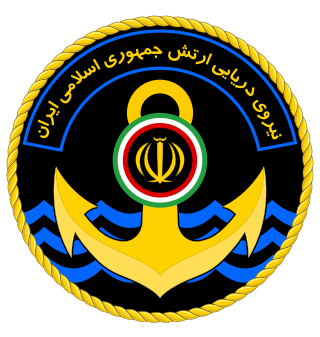
The Islamic Republic of Iran Navy or Iranian Navy, officially abbreviated NEDAJA, is the naval warfare service branch of Iran's regular military, the Islamic Republic of Iran Army (Artesh). It is one of Iran's two maritime military branches, alongside the Navy of the Islamic Revolutionary Guard Corps (IRGC).

Sea Fighter (FSF-1) is an experimental littoral combat ship in service with the United States Navy. Its hull is of a small-waterplane-area twin-hull (SWATH) design, provides exceptional stability, even on rough seas. The ship can operate in both blue and littoral waters. For power, it can use either its dual gas-turbine engines for speed or its dual diesel engines for efficient cruising. It can be easily reconfigured through the use of interchangeable mission modules. Helicopters can land and launch on its deck. Smaller water craft can be carried and launched from its stern. The vessel is being developed under the program title Littoral Surface Craft-Experimental with a hull type designation Fast Sea Frame. The first vessel has been assigned the hull classification symbol FSF 1 and also has been referred to as the X-Craft. The vessel was designed by British company BMT Nigel Gee who continue with a role in the development of the vessel.

The Navy of the Islamic Revolutionary Guard Corps is the naval warfare service of the Islamic Revolutionary Guard Corps founded in 1985, and one of the two maritime forces of Iran, parallel to the conventional Islamic Republic of Iran Navy. The IRGC has been designated as a terrorist organization by the governments of Bahrain, Saudi Arabia and the United States. IRGC's Navy has steadily improved its capabilities to support unconventional warfare and defend Iran's offshore facilities, coastlines, and islands in the Persian Gulf.

A green-water navy is a maritime force that is capable of operating in its state's littoral zones and has limited competency to operate in the surrounding marginal seas. It is a relatively new term, and has been created to better distinguish, and add nuance, between two long-standing descriptors: blue-water navy and brown-water navy.
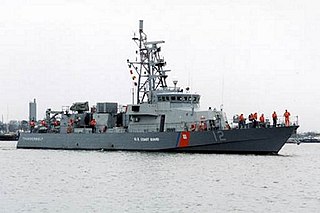
USS Thunderbolt (PC-12) is the twelfth Cyclone-class patrol ship. Thunderbolt was laid down 9 June 1994 by Bollinger Shipyards, Lockport, Louisiana, and launched 2 December 1994. She was commissioned by the United States Navy on 7 October 1995.

The C 14-class missile boat is a light missile boat of catamaran designed for use in the Middle East, also known as the China Cat class. The small size of the ship, along with some stealth features provide it with good protection against enemy detection, and it can be armed with a variety of light anti-ship missiles. In addition to the low radar cross section, the boat is also extremely fast with an aluminum monohull with stepped planning.

The Type 22 missile boat is a ship class in the Chinese People's Liberation Army Navy. The first boat was launched in April 2004 by the Hudong-Zhonghua Shipyard at Shanghai. The boats incorporate stealth features and are based on Australian-designed wave-piercing catamaran hulls that are more stable than other fast missile craft in high sea conditions. 82 of these missile boats are currently in service with three flotillas having been produced over a span of seven years, operating in squadrons of eight vessels each.
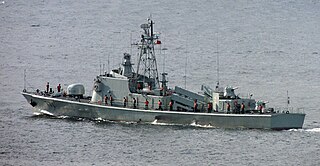
The Type 037 corvette is a series 400–500 ton corvette type classes in service with the People's Liberation Army Navy. Unlike western navies, the People's Liberation Army Navy does not have dedicated patrol boats in its inventory. Instead, a large variety of corvette type classes, in the form of missile boats and submarine chasers fulfill the tasks of patrolling China's territorial waters. The Egyptian Navy operates eight vessels.

Austal Limited is an Australian-based global ship building company and defence prime contractor that specialises in the design, construction and support of defence and commercial vessels. Austal's product range includes naval vessels, high-speed ferries, and supply or crew transfer vessels for offshore windfarms and oil and gas platforms.

The Roussen class is a seven-strong class of British-designed fast attack missile boats improved and customized for the Hellenic Navy, also known as Super Vita. The class is named after its lead ship, which in turn is named after Lt Nikolaos Roussen, a World War II submarines officer who was killed in the suppression of the Navy mutiny in April 1944.
Intermarine is an Italian shipbuilding company, owned by the Rodriquez Cantieri Navali Group.
The Great Prophet IX was an Iranian war games exercise in the general area of the Strait of Hormuz on Larak Island, Persian Gulf. It started on February 25, 2015, and finished on February 27, 2015. The exercise was notable for using a full scale mock-up of an American aircraft carrier as a target.
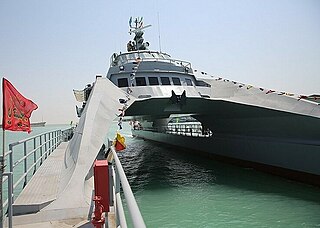
Shahid Nazeri is a high-aspect-ratio twin-hull vessel operated by the Navy of the Islamic Revolutionary Guard Corps of Iran.

The Ashura is a class of fast patrol boat used by naval forces of Iran. It is a Boston Whaler type vessel based on a Watercraft UK design, and is manufactured domestically with hulls made of glass-reinforced plastic.
Various series of rigid inflatable boat (RIB) are operated by naval forces of Iran. Based on a design by Italian Fabio Buzzi, they have been manufactured and modified in Iran.
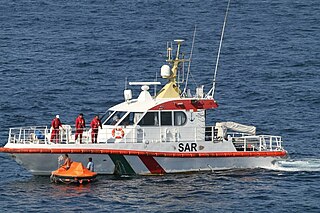
Heidar is a class of boats built and operated by Iran, mainly for maritime patrol and search and rescue missions.

Shahid Roudaki is a warship operated by the Navy of the Islamic Revolutionary Guard Corps of Iran that is capable of carrying aircraft, missile launchers and drones.

Shahid Soleimani is the lead ship of an Iranian class of missile corvettes with the same name. It was built by the Shahid Mahallati Shipyard and is operated by the Islamic Revolutionary Guard Corps Navy of Iran.